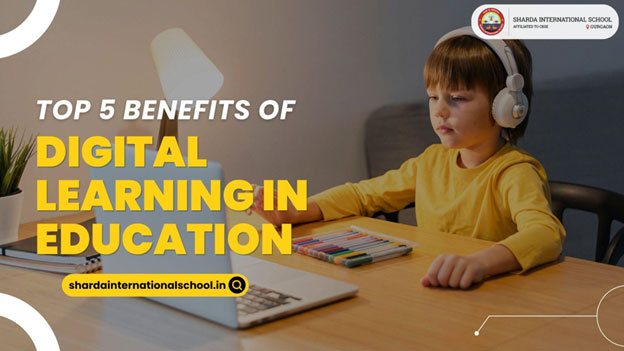Top 5 Benefits of Digital Learning in Education
 The way students and teachers interact has completely changed
thanks to digital learning. Over the last few years, especially
during and after the COVID-19 pandemic, we've seen digital tools
play a much bigger role in education. A report by the World
Economic Forum highlighted that over 1.2 billion children were
impacted by school closures worldwide during the pandemic, which
pushed digital learning in education to the forefront. According
to a McKinsey survey, 77% of teachers now believe digital tools
have made a noticeable improvement in student engagement. With
these figures in mind, it’s clear that digital learning has some
amazing benefits. Let’s go over the top five.
The way students and teachers interact has completely changed
thanks to digital learning. Over the last few years, especially
during and after the COVID-19 pandemic, we've seen digital tools
play a much bigger role in education. A report by the World
Economic Forum highlighted that over 1.2 billion children were
impacted by school closures worldwide during the pandemic, which
pushed digital learning in education to the forefront. According
to a McKinsey survey, 77% of teachers now believe digital tools
have made a noticeable improvement in student engagement. With
these figures in mind, it’s clear that digital learning has some
amazing benefits. Let’s go over the top five.
Advantages Of Digital Learning In Education System
1. Flexibility and Convenience
One of the biggest perks of digital learning is the flexibility it
offers both students and teachers. Unlike traditional classroom
setups, where everyone has to follow a strict schedule, digital
learning allows students to learn and complete assignments at
their own pace. This is particularly helpful for students juggling
other commitments, like part-time jobs or family responsibilities.
Teachers can also benefit, as they can design courses that
students can access at any time, ensuring learning continues
beyond the classroom.
The beauty of digital learning in education is that students from
different time zones or locations can still access the same
resources and get the same education. This flexibility encourages
more self-directed learning, allowing students to explore subjects
in their own time and go over lessons as often as needed.
2. Personalized Learning Experience
Digital learning in education platforms have a fantastic way of
personalizing education based on each student’s learning style and
pace. With adaptive learning technologies, students can receive
tailored feedback and study plans that align with their progress.
For instance, if a student is having difficulty with a particular
subject, the platform can adjust the material or suggest
additional resources to help them catch up.
This personalized approach makes learning more engaging and
effective. A study by the Bill & Melinda Gates Foundation found
that personalized learning can lead to noticeable improvements in
student outcomes. Students feel more in control of their own
learning, which in turn boosts their confidence and motivation to
keep going.
3. Access to a Wide Range of Resources
The internet provides an endless amount of digital learning in
education resources like videos, e-books, podcasts, interactive
simulations, and more, all of which can enrich the educational
experience. With digital learning, students aren’t restricted to
textbooks or the resources available in their school library.
Instead, they can tap into global expertise, join discussions with
other students from around the world, and even participate in
virtual field trips.
Having access to such a wide variety of resources caters to
different learning styles. For example, visual learners can
benefit from watching video tutorials, while auditory learners
might find podcasts more effective. This range of materials helps
keep learning interesting and encourages students to explore
subjects that might have been harder to access before.
4. Cost-Effective and Environmentally Friendly
Digital learning can also help cut down on costs. By moving away
from physical textbooks, notebooks, and paper, both schools and
students can save money. For instance, the National Center for
Education Statistics notes that college students spend an average
of $1,240 annually on textbooks. Switching to digital resources
can significantly reduce these costs, making education more
affordable.
Not only is it more cost-effective, but digital learning in
education is also better for the environment. By reducing the need
for paper and other physical materials, we can lessen the
environmental impact of education. Schools that adopt more digital
tools contribute to sustainability while creating a more modern
and efficient learning environment.
5. Enhanced Collaboration and Communication
Finally, digital learning in education fosters better
communication and collaboration between students and teachers.
Virtual classrooms, discussion boards, and online group projects
make it easier for students to work together, no matter where they
are. Teachers can also provide real-time feedback, share resources
instantly, and even hold live sessions, all of which make
communication smoother and more effective.
Many digital platforms come equipped with tools like chat rooms,
video calls, and collaborative documents, which allow students to
work together seamlessly. This level of interaction helps develop
teamwork skills, which are essential for students as they move
forward in their careers.
Conclusion
Digital learning in education has completely changed the way we
approach education, offering flexibility, personalized learning,
access to diverse resources, and improved collaboration.
Statistics show that this shift toward digital education isn’t
just a temporary trend. More schools and institutions are now
embracing these methods as a core part of their teaching
strategies.
Sharda International School knows the importance of connecting
with
digital education in India, we prepare our students for the present and future. Our main
goal is that our students must know what’s trending in the market.
Also, our teachers play a crucial role in making our students
future-ready. As we continue to explore the potential of digital
learning, we’re paving the way for a more engaging, accessible,
and sustainable future in education.